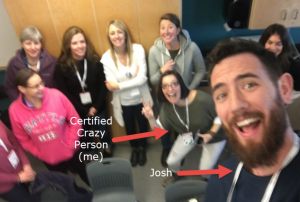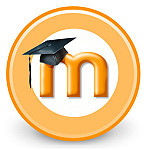This last month has been somewhat of a blur.
As luck would have it, my group presentation was exactly one week before my Pitch Assignment, resulting in 50% of my grade being determined in a very short period of time.
Although some folks would prefer to have the band-aid ripped off quickly, when it comes to completing projects for my Master degree, I am not a fan!
“Mum. You’ve had too much screen time.”
…said my son, as I lay in a crumpled heap at the base of his bed. Yes, Son. I have.
Punch One: Digital Textbooks, An Opportunity Forecast
What I am particularly proud of is that my group produced our project as a digital textbook. As obvious as this may seem to do, from what I can tell, groups of the past created websites to present. As time was short and three people were working on their own chapters, the cohesion of our book could have used a bit of glue. With more time to fine-tune, I would have liked to have planned the aesthetic of our book a bit more. It is not terrible, however, and the look of the book is pretty slick, overall. One of our goals was to include as many different features to our book as possible: quizzes, timelines, videos, images, PDFs, sidebars, SoundCloud, etc. This resulted in the book being less “book-y” and more “website-y”.
The platform that we chose was Avatist. I would definitely use this Platform again. Limitations on the free version included not being permitted to have more than 5 editors at a time. This was problematic since our entire class was slated to create a group book, as their weekly activity. We worked around this by having classmates fill out a Google Form that indicated which chapters they preferred to work on and which days they were available. I was able to schedule everyone, and conflicts were easily avoided. Another warning to any who chooses to undertake a similar activity is that if two editors are working at the same time, on the same chapter, then only the last person to save will have their work saved. The other person’s work will be lost! #goodtoknow
To view our opportunity forecast on Digital Textbooks, click here. My major contribution was to Chapter 1, where I probably spent a little too much time on that timeline. It really became a passion project, however. Should the history of textbooks from the very first to where we are today, is of interest to you, have a peek!
To view our collaborative book, click here. Each student in ETEC 522 contributed to one or two chapters of our Tips and Tricks book for being a UBC MET student. I would like to add to another chapter or two myself, and I would also like to set up a system to allow other MET students, past or present, the opportunity to contribute. The bigger the book the better, no? Send me a message if you would like to contribute!
Punch Two: My Business Pitches
I think for this blog entry, I will take a shortcut and post my Reflection for the project. It sums up things pretty nicely! Here is a link to my work via the course’s blog, where one can access my project and read comments from my classmates. For just the project, see below:
My Reflection
- Strengths: The biggest strength to the Third Space Learning pitch is that it provides forward yardage in a cultural playing field that has been unfairly refereed for too many decades. The idea itself is solid, is needed, and not only that, it has the potential to perpetuate more ideas that nurture culturally responsive learning spaces. I feel that not only my passion for the topic was evident, but that I created a realistic venture opportunity. Every statistic that I used was sourced from reputable websites (BCTF, SD61, StatsCanada, The Government of Canada). The only fictitious value was fabricated from the grant money, however, the actual grant does exist, should I wish to pursue my venture. The cost of creating the videos came from a local videographer, as well; overall, I am very proud of the fact that this venture was researched to the best of my abilities. I also feel that I produced a product that thoroughly describes the pain point and that I feel like my pitch told a story, as opposed to merely checking the venture pitch boxes. I think that my favorite part the project was the creation of the Elevator Pitch. My friend Gail, who agreed to be part of my Team, said that seeing the school and listening to my message made her tear up, as she only just left our school last summer. Having my friend’s support fills my heart.
- Weaknesses: I really valued Cassy’s comments (her input throughout the course was truly remarkable, actually). In her feedback, she would have liked to have learned more about distribution networks: “…this content is great but only if the right eyeballs are on it”, she wrote. Jonathon also mentioned wanting to learn more about the next steps, beyond the videos. Both Cassy’s and Jon’s comments are very valid, and should I ever move forward with this venture, I will address those deficits. I clearly went overtime for my venture pitch, and I think that if I had started this project earlier, I would have been able to find some additional edits. I think that I put about 50 hours into this project, however, and once I had completed the slides, I had personally attached myself to them too much. When I posted the final project, it was akin to biting into apple pie immediately after it comes out of the oven. I recognize that projects, like fresh baked pie, need time to cool before submitting! Another issue I had was simply making the videos so that the sound quality was not horrible. In the end, because I was not able to figure this one out in a timely manner, my audio for my venture pitch was not as solid as I would have liked. Consequently, I simply did not have enough time to do a fourth take. In general, time management is not one of my strengths, at all.
- Key takeaways:
- A large amount of my time was spent watching YouTube videos and reading articles on how to make a great pitch. Although I may not have mastered the steps, I feel like I have a decent foundation on the pitch components. This legwork allowed me to more easily see the strengths and deficits in other pitches, as well.
- I thoroughly enjoyed creating the two videos, despite having to overcome a few steep learning curves. I learned that in these pitches, it is better to have fewer words on the slides. Although website pitches were of excellent quality, I did not enjoy my classmates’ website pitches as much as the video pitches since they were very wordy. Because of this, I ranked Robert’s and Shannon’s the highest (out of the ten that I reviewed). Both classmates created final products that not only covered the bases but were easier for me to follow. I am but a simple math and physics type; too many words and I get bored. (How I made it to the end of Course 8 in MET is somewhat astonishing to me!!!)




 rned well from traditional classroom models, however, since undertaking a degree that is delivered in a on-line format, I have been forced to adapt my preferred learning style!
rned well from traditional classroom models, however, since undertaking a degree that is delivered in a on-line format, I have been forced to adapt my preferred learning style!